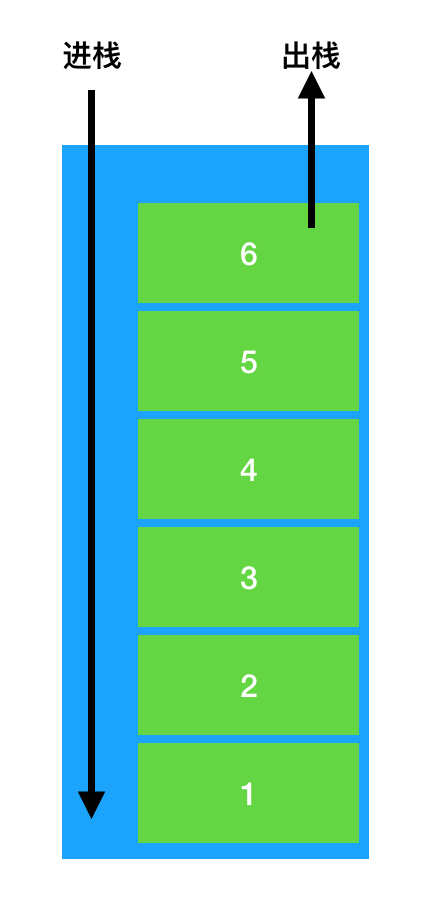一、栈的介绍
栈作为一种数据结构,是一种只能在一端进行插入和删除操作。它按照先进后出的原则存储数据,先进入的数据被压入栈底,最后的数据在栈顶,需要读数据的时候从栈顶开始弹出数据(最后一个数据被第一个读出来)。栈被使用于非常多的地方,例如浏览器中的后退按钮,文本编辑器中的撤销机制。

进栈的时候是1先进,然后是2、3、4、5、6,出栈的时候是先6出,然后是5、4、3、2、1
二、栈中常用的方法
作为一个栈(用stack来表示),最基本的方法有下面几个:
-
stack.push(e): 将元素e添加到S的栈顶
-
stack.pop(): 从栈S中移除并返回栈顶的元素,如果此时栈是空的,那么这个操作将会报错
-
stack.top(): 不移除栈顶元素,但返回栈顶元素,如果此时栈是空的,那么这个操作将会报错
-
stack.is_empty(): 如果栈为空,则返回True,否则返回False
-
len(stack): 返回栈中元素的数量,使用len的特殊方法实现
- stack.travel()遍历栈里面的元素
三、栈的python代码实现
class Stack(): """ 以list为基础实现的栈 """ def __init__(self): self._data = [] def __len__(self): return len(self._data) def is_empty(self): if len(self._data) == 0: return True else: return False def push(self, e): self._data.append(e) def pop(self): if self.is_empty(): print("栈为空") return return self._data.pop() def top(self): if self.is_empty(): print("栈为空") return return self._data[-1] def travel(self): for i in range(0,len(self._data)): print("%d"%self._data[i]) if __name__ == '__main__': print("创建栈") stack = Stack() stack.pop() print("验证是否为空:",end="") empty = stack.is_empty() if empty == True: print("空栈") else: print("不是空") print("进栈") stack.push(1) stack.push(2) stack.push(3) stack.push(4) stack.push(5) stack.push(6) print("遍历验证进栈") stack.travel() print("判断是否为空:",end=" ") empty = stack.is_empty() if empty == True: print("空栈") else: print("不是空") print("出栈:",end=" ") pop = stack.pop() print(pop) stack.travel() print("验证栈顶元素:",end=" ") top = stack.top() print(top)
运行结果为:
创建栈 栈为空 验证是否为空:空栈 进栈 遍历验证进栈 1 2 3 4 5 6 判断是否为空: 不是空 出栈: 6 1 2 3 4 5 验证栈顶元素: 5
四、栈的C语言代码实现
// main.m // 栈 // Created by 侯垒 on 2019/7/3. // Copyright © 2019 可爱的侯老师. All rights reserved. # include<stdio.h> typedef struct N { int num; struct N *next; }Node; Node * createNode(int num) { Node *node = (Node *)malloc(sizeof(Node)); node->num = num; node->next = NULL; return node; } Node * createStack() { Node *head = NULL; return head; } int is_empty(Node *head) { if (head == NULL) { return 1; } else { return 0; } } int length(Node *head) { Node *current = head; if (is_empty(head)) { return 0; } int count = 1; while (current->next!=NULL) { count++; current = current->next; } return count; } Node *push(Node *head, int num) { Node *node = createNode(num); if (is_empty(head)==1) { head = node; } else { Node *current = head; while (current->next!=NULL) { current = current->next; } current->next = node; } return head; } Node *pop(Node *head) { if (is_empty(head) == 1) { printf("站为空"); return head; } else { Node *current = head; int len = length(head); if (len == 1) { head = NULL; } else { for (int i=0; i<len-2;i++) { current = current->next; } current->next = NULL; } } return head; } int top(Node *head) { if (is_empty(head)) { printf("栈为空"); return -1; } return head->num; } void travel(Node *head) { if (is_empty(head) == 1) { printf("站为空 "); } else { Node *current = head; int len = length(head); for (int i = 0; i<len; i++) { printf("%d ",current->num); current = current->next; } printf(" "); } } int main(int argc, const char * argv[]) { printf("创建栈 "); Node *head = createStack(); printf("验证是否为空: "); int empty = is_empty(head); if (empty == 1) { printf("栈为空 "); } else { printf("栈不为空 "); } printf("验证进栈 "); head = push(head, 1); travel(head); head = push(head, 2); head = push(head, 3); head = push(head, 4); head = push(head, 5); head = push(head, 6); travel(head); printf("验证栈顶元素 "); int t = top(head); printf("top = %d ",t); printf("验证出栈 "); head = pop(head); travel(head); head = pop(head); travel(head); head = pop(head); travel(head); head = pop(head); travel(head); head = pop(head); travel(head); head = pop(head); travel(head); return 0; }
运行结果为:
创建栈 验证是否为空: 栈为空 验证进栈 1 1 2 3 4 5 6 验证栈顶元素 top = 1 验证出栈 1 2 3 4 5 1 2 3 4 1 2 3 1 2 1 站为空